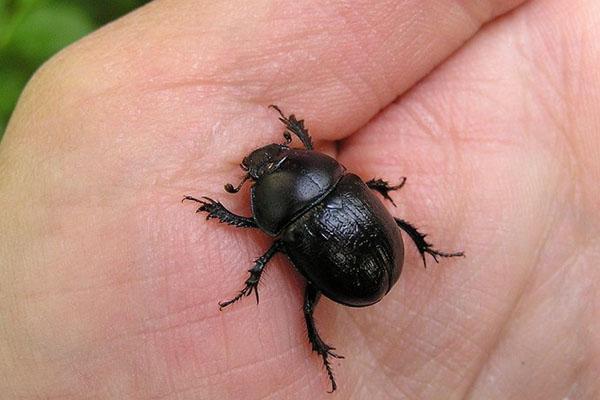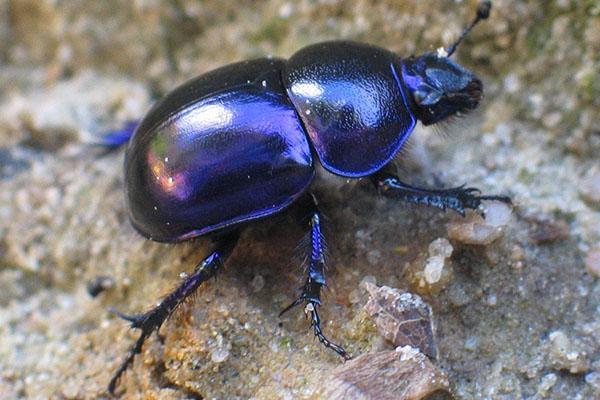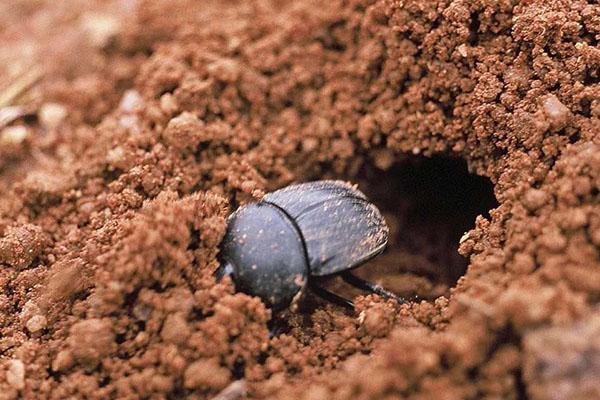The dung beetle lives in the country
 The dung beetle is a fairly useful insect that is undeservedly considered harmful. It can be distinguished by its large chest, heavy body and the classic dung ball included. The insect belongs to the family of excavators, spends most of its life under it.
The dung beetle is a fairly useful insect that is undeservedly considered harmful. It can be distinguished by its large chest, heavy body and the classic dung ball included. The insect belongs to the family of excavators, spends most of its life under it.
Appearance

The color of the abdomen is constant - violet-blue. The upper jaw of the dung beetle has a rounded shape. The antennae of an insect with eleven segments are covered with a short downy. Their tips are twisted into heads with three ramifications. The abdominal shield is strewn with several points. Each individual elytron has fourteen grooves. The beetle weighs about two grams.
Dung beetle behavior
 This beneficial insect is of great benefit to the earth, loosening and saturating it with oxygen. In the process of processing manure the beetle rolls it into balls and sends it to its burrows, where it decomposes into organic components, which also contributes to fertilizing the soil, increasing yields and improving sanitary conditions.
This beneficial insect is of great benefit to the earth, loosening and saturating it with oxygen. In the process of processing manure the beetle rolls it into balls and sends it to its burrows, where it decomposes into organic components, which also contributes to fertilizing the soil, increasing yields and improving sanitary conditions.
This type of beetle prefers a temperate climate; there are rare individuals that have adapted to arid conditions. The main thing for insects is sufficient food for adult beetles and larvae. The only areas unsuitable for dung beetle settlement are the territories of the Far North.
Varieties of dung beetles
 Currently, there are two predominant varieties of dung beetles:
Currently, there are two predominant varieties of dung beetles:
- Coprophaga. This group includes beetles with a large chest plate and powerful shins of the frontal paws, which allow the beetles to fully realize their digging activity. There are species with distinctively highlighted sexual characteristics.
- Ateuchus (Scarabaeus). The most significant distinguishing feature of this group is that their eyes are bifurcated, and their head shield is a semicircle. The dimensions of the largest individuals do not go beyond 4 cm. They are most common in southern Europe and northern Africa.
The difference between the first and the second groups is that the beetles of the first group have a closed-type leathery shell on the upper lip and jaw, while in the second they are hard and open.
Reproduction and larvae
 In terms of the development cycle, the dung beetle hardly differs from other analogues. The larva looks like a worm with legs; an adult insect appears as a result of pupation. To feed the larvae, the beetle rolls manure into balls, puts each in a separate chamber and attaches an egg to it. This provides the baby with food for the entire developmental period.
In terms of the development cycle, the dung beetle hardly differs from other analogues. The larva looks like a worm with legs; an adult insect appears as a result of pupation. To feed the larvae, the beetle rolls manure into balls, puts each in a separate chamber and attaches an egg to it. This provides the baby with food for the entire developmental period.
The larvae feed on manure from 3 months to a year, which is prepared by the parents, while their feces accumulate in a kind of bag. In the spring, the larvae grow and turn into pupae, and after a while, adults emerge from them. The appearance of the larvae is a thick, clumsy body with powerful jaws.
Beetle benefits
 The usefulness of the dung beetle is told by an instructive story that occurred in Australia during the reign of European colonists.With the import of a large number of livestock into the country, the pastures on which it grazed quickly lost its nutritional value. The specialists found that due to the layer of manure, the grass did not break through to the surface.
The usefulness of the dung beetle is told by an instructive story that occurred in Australia during the reign of European colonists.With the import of a large number of livestock into the country, the pastures on which it grazed quickly lost its nutritional value. The specialists found that due to the layer of manure, the grass did not break through to the surface.
In the process of processing manure, the beetle rolls them into balls and sends them to their burrows, where they decompose into organic components, which also contributes to fertilizing the soil, saturating it with oxygen, increasing yields and improving sanitary conditions.
There were no dung beetles on these lands then. Scientists-entomologists have selected several species of dung beetles and launched them on the continent. Environmental disaster, economic problem and national tragedy were averted.
The dump is useful, do not confuse it with beetle.
Dung beetle feeding
 The formation of the dung beetle larva can take from 3 months to several years, because the dung contains a huge amount of useful and nutrients. Some individuals continue to be in a ball of manure, even taking the form of a beetle, until the development of a full-fledged organism ends.
The formation of the dung beetle larva can take from 3 months to several years, because the dung contains a huge amount of useful and nutrients. Some individuals continue to be in a ball of manure, even taking the form of a beetle, until the development of a full-fledged organism ends.
After that, the dung beetle crawls out to the ground and begins to look for food for itself on its own. The dunger prefers horse manure or cattle excrement, if the former is not available. Moves in search of food mainly in the evening. Along with this, certain species of beetles can feed not only on manure, but also on fungi with detritus, and there are those that do not feed at all.
Further life of adult beetles
The life of an adult beetle stops as soon as a suitable place for further breeding is found. Two beetles close the entrance tightly and begin to lay eggs, with which they will exist for the entire period of the remaining life. The male and female die about a month after they begin to lay eggs and guard their offspring, as they sit in the burrow without the opportunity to get food and feed themselves.